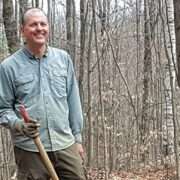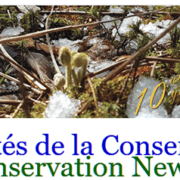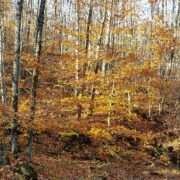Matthew Cleary came to Canada from California. He had been working in national and state parks in the USA and moved here with his skills and his Québecoise wife in 2008 to raise their family. Our trail director, Mahicans Diamond, met Matthew in the region and soon they became good friends through their shared experiences.
Mahicans called Matthew to team up with him and build the trails at Scowen Park in North Hatley. Together they have been working on the Massawippi trails since the Trust first started to build them six years ago.
Everyone, without exception, that I have met has enjoyed their walking experience and many have said they are the best trails they have ever used. Known for their natural, easy going surfaces that blend into the environment, the Trail has been “discovered” during the pandemic as one of the best kept secrets. Some people want to keep it a secret, but not Matthew. When asked what he wanted to see in ten, twenty or thirty years, he replied, ‘’ I hope our network of trails will become widely known and that people come to use and enjoy them. It is good for their health and for others to see people walking, knowing they are not alone in this endeavor to enjoy the woods. It is good for the health of a community.’’
Our network reflect the personality of the trail builders. When I first met Matthew, I was struck by his kindness and generosity of spirit. As the Massawippi Trail foreman he is responsible to bring Mahicans’ dreams to life. He is practical man, a teacher, someone who studies the forest, it’s natural and human history. He notes the way people have left their imprint on the land. Smiling, he tells the story of cleaning Ethan’s beach and finding the history of Quebec beer through the bottles and cans people had left in the woods. An anthropologist perhaps, but first and foremost a trail builder who wants to build paths through the forest that respect the environment as well as creating a safe, friendly space for people to benefit from the woodlands.
Matthew is part of a team of three professional trail builders. Each summer, students are hired to be trained and work alongside the professionals. Matthew is their teacher and guide. I think it is a testament to the quality of their experience that the students often return for a second and third year. He loves their enthusiasm and desire to learn new skills building the trails. It is one of his favorite aspects of the job.
In the Spring, Mahicans and Matthew study the terrain and lay out a plan for each section they plan to build that year. Depending on the year, they build between two and three kilometers of trail. The Massawippi Conservation Trust who owns the land and is responsible for its conservation has a goal of building up to 25 kilometers of trails in all.
The Trails is mostly built by hand. Occasionally some equipment is brought in for a particular section or piece of work but generally the builders use human power and ingenuity such as ropes and pulleys to haul logs and rocks. 90% of the materials used are from the surrounding forest. Matthew says not only does this save money but it is also means they are not introducing any foreign substances that might alter the biodiversity.
He speaks respectfully about cutting trees to be used on the stairs and other infrastructure. “If you remove one tree from a spot, it means more light, more water for the smaller trees who can then grow faster.” He selects trees which are tall and straight (less waste) and those that are close to other trees. Or he chooses those that are in danger of falling down. “I hate to cut a tree but I don’t feel guilty because we are not removing anything from the system.”
Rocks, carefully selected from the forest, help people cross streams and line the edges of the trails to prevent erosion. Steps are built of logs, whose bark is removed and that are flattened on top to create a natural spot to place your foot. The trails follow the contours of the land. The person walking is considered, adding steps where the incline might be too steep to climb or a rock bridge to help them hop across a gully.
Margot Heyerhoff, President of the Massawippi Foundation which is the funding arm of the Massawippi Conservation Trust added this comment:
”From our earliest days, our Board decided it wanted to put ecologically sensitive trails into our protected properties. We felt that it was not enough to just admire this conserved mountain from driving along Route 143 on the other side of the lake. We wanted people to be able to experience what had been conserved by being inside this amazing forest. Matthew is helping make our dreams a reality.”
The trail network is almost complete on Wardman sector. This summer Matthew and the team will finish the loop on the Wippi North trail and then move onto a whole new section of the property.
No longer a secret, I think Matthew is pleased to know that the result of the hard work of the team has paid off and has helped so many find a healthier balance in life by walking here during the past difficult year.
I look forward to walking under the green canopy very soon and hope to run into Matthew and the trail builders who will be back at work in May. If you see them, please stop and say hello.






